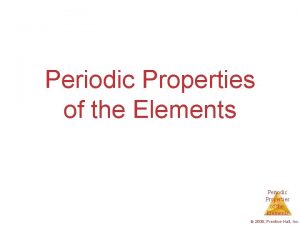Properties of Solutions 2009 PrenticeHall Inc Solutions Solutions















- Slides: 15

Properties of Solutions © 2009, Prentice-Hall, Inc.

Solutions • Solutions are homogeneous mixtures of two or more pure substances. • In a solution, the solute is dispersed uniformly throughout the solvent. Solutions © 2009, Prentice-Hall, Inc.

Solutions The intermolecular forces between solute and solvent particles must be strong enough to compete with those between solute particles and those between solvent particles. Solutions © 2009, Prentice-Hall, Inc.

How Does a Solution Form? As a solution forms, the solvent pulls solute particles apart and surrounds, or solvates, them. Solutions © 2009, Prentice-Hall, Inc.

How Does a Solution Form If an ionic salt is soluble in water, it is because the iondipole interactions are strong enough to overcome the lattice energy of the salt crystal. Solutions © 2009, Prentice-Hall, Inc.

Energy Changes in Solution • Simply put, three processes affect the energetics of solution: – separation of solute particles, – separation of solvent particles, – new interactions between solute and solvent. Solutions © 2009, Prentice-Hall, Inc.

Energy Changes in Solution The enthalpy change of the overall process depends on H for each of these steps. Solutions © 2009, Prentice-Hall, Inc.

Why Do Endothermic Processes Occur? Things do not tend to occur spontaneously (i. e. , without outside intervention) unless the energy of the system is lowered. Solutions © 2009, Prentice-Hall, Inc.

Why Do Endothermic Processes Occur? Yet we know the in some processes, like the dissolution of NH 4 NO 3 in water, heat is absorbed, not released. Solutions © 2009, Prentice-Hall, Inc.

Enthalpy Is Only Part of the Picture The reason is that increasing the disorder or randomness (known as entropy) of a system tends to lower the energy of the system. Solutions © 2009, Prentice-Hall, Inc.

Enthalpy Is Only Part of the Picture So even though enthalpy may increase, the overall energy of the system can still decrease if the system becomes more disordered. Solutions © 2009, Prentice-Hall, Inc.

Student, Beware! Just because a substance disappears when it comes in contact with a solvent, it doesn’t mean the substance dissolved. Solutions © 2009, Prentice-Hall, Inc.

Student, Beware! • Dissolution is a physical change — you can get back the original solute by evaporating the solvent. • If you can’t, the substance didn’t dissolve, it reacted. Solutions © 2009, Prentice-Hall, Inc.

Types of Solutions • Saturated – In a saturated solution, the solvent holds as much solute as is possible at that temperature. – Dissolved solute is in dynamic equilibrium with solid solute particles. Solutions © 2009, Prentice-Hall, Inc.

Types of Solutions • Unsaturated – If a solution is unsaturated, less solute than can dissolve in the solvent at that temperature is dissolved in the solvent. Solutions © 2009, Prentice-Hall, Inc.
 2009 pearson education inc
2009 pearson education inc 2009 pearson education inc
2009 pearson education inc 2009 pearson education inc
2009 pearson education inc Copyright 2009
Copyright 2009 2009 pearson education inc
2009 pearson education inc 2009 pearson education inc
2009 pearson education inc Copyright 2009 pearson education inc
Copyright 2009 pearson education inc 2009 pearson education inc
2009 pearson education inc Copyright 2009 pearson education inc
Copyright 2009 pearson education inc Copyright 2009 pearson education inc
Copyright 2009 pearson education inc Copyright 2009 pearson education inc
Copyright 2009 pearson education inc Jay conroy, cnn
Jay conroy, cnn Intensive and extensive properties
Intensive and extensive properties Physical and chemical properties
Physical and chemical properties Subnet.com
Subnet.com Quartz solutions inc
Quartz solutions inc





























